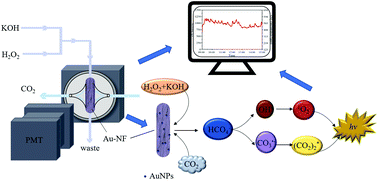Fabric-based in situ synthesis of gold nanoparticles for continuous enhanced heterogeneous chemiluminescence online detection of carbon dioxide
Abstract
In this paper, nylon microfiber fabric with a heterogeneous chemiluminescence system was used for the synthesis of gold nanoparticles (AuNPs) for the first time, and it was used to enhance the online detection of carbon dioxide (CO2) by heterogeneous chemiluminescence. Nylon microfiber fabric was chosen as the gas–liquid heterogeneous chemiluminescence micro reaction interface. The thermal reduction method prepared the micro reaction interface with in situ synthesized AuNPs. The solution of H2O2 and KOH forms a liquid film on the surface of the micro reaction interface, and a heterogeneous chemiluminescence reaction occurs when CO2 flows through the surface of the liquid film. The AuNPs supported in situ on the micro reaction interface act catalytically and enhance the chemiluminescence signal for CO2 detection. In this way, AuNPs can be used repeatedly in the chemiluminescence reaction, avoiding the waste of precious metal nanoparticles and reducing the detection cost. Under the optimal conditions, CO2 has a good linear relationship with the chemiluminescence signal in the range of 10–20 000 ppm (v/v). The correlation coefficient R2 is 0.9963, the detection limit is 0.35 ppm (v/v), and the relative standard deviation is 1.79%. This approach provides an entirely new technological platform for the development of functional fabrics and the maximum utilization of precious metal nanoparticles.



 Please wait while we load your content...
Please wait while we load your content...